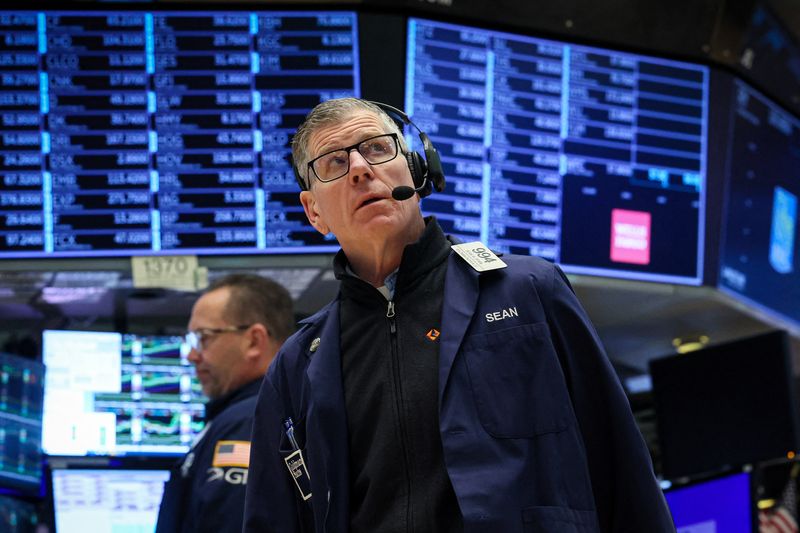The major U.S. stock indices ended last week on a low, with the Nasdaq Composite falling for the sixth consecutive session on Friday, marking its longest losing streak in over a year.
This decline was exacerbated by a significant drop in Nvidia (NASDAQ:NVDA), amidst broader market challenges including geopolitical tensions and persistent inflation.
The tech-focused Nasdaq retreated 2.05% to close at 15,282.01, while the broader S&P 500 also experienced a downturn, sliding 0.88% to end at 4,967.23. This decline brought both indices to their sixth consecutive day of losses, a negative streak not observed since October 2022.
Conversely, the Dow Jones Industrial Average saw an increase, rising 211.02 points, or 0.56%, to close at 37,986.40. This rise was primarily fueled by a surge of over 6% in American Express (NYSE:AXP) following its earnings report.
On a weekly basis, the S&P 500 saw its worst weekly performance since March 2023, driven by increasing concerns over inflation and monetary policy directions. With a loss exceeding 3%, this marked the large-cap benchmark’s third consecutive negative week.
Much of this downward pressure was due to poor performance in the technology sector, which was the worst-performing sector in the S&P 500 during the week. The index is currently over 5% below its 52-week high.
This week, much of the market’s attention will likely be focused on major economic events including the release of the durable goods report on Wednesday, followed by the advance GDP report for the first quarter on Thursday, and the core PCE inflation report on Friday.
“We estimate personal income increased 0.50% and personal spending increased 0.65% in March,” Goldman Sachs (NYSE:GS) economists said in a recent note.
“We estimate that the core PCE price index rose +0.30%, corresponding to a year-over-year rate of 2.76%. Additionally, we expect that the headline PCE price index increased by 0.31% from the prior month,” they added.
During this period, Federal Reserve officials will not be commenting on monetary policy due to the blackout period preceding the Federal Open Market Committee (FOMC) meeting scheduled for April 30-May 1.
Big Tech earnings reports in the spotlight
In addition to key economic developments, investors and analysts will also be closely scrutinizing the upcoming earnings report releases this week.
On Monday, Citi strategists said they have revised their multi-variable regression analysis that combines key macroeconomic indicators with S&P 500 earnings growth.
Their updated analysis indicates "a very high likelihood of a positive Q1 EPS surprise, but relatively limited guidance follow-through," they said.
“Better-than-expected macro data and rising projections imply there is a 50% chance of the S&P 500 reaching or exceeding our $245 full-year earnings estimate. For context, that probability was circa 30% in November,” analysts wrote.
Several earnings reports will be in the spotlight in the coming days, most notably those by mega-cap giants including Tesla (NASDAQ:TSLA), Meta Platforms (NASDAQ:META), Alphabet (NASDAQ:GOOGL), and Microsoft (NASDAQ:MSFT).
What analysts are saying about US stocks
Oppenheimer: “With only 70 or 14% of the firms in the S&P 500 index having reported it’s still too early to make any definitive statements about the season so far. That said, earnings so far are up 9.4% from a year earlier on 4.5% revenue growth; and 80% of firms that have reported so far have beaten expectations. Several cyclical sectors including technology, communications and consumer discretionary are showing double-digit earnings growth for the sample of companies that have reported.
UBS: “Volatility has returned to markets after an unusually smooth rally in equities since late October. In our view, markets could remain choppy in the near term as geopolitical risks remain elevated, and markets adjust to a likely delay in the start of US rate cuts. But we would caution against exiting markets in response to flare-ups in international conflicts. Barring a serious disruption to oil supplies or trade routes, which remains a risk, the effects of such episodes has tended to be short-lived.”
“Since the attack on Pearl Harbor in 1941, the S&P 500 has been higher two-thirds of the time, 12 months after the start of a crisis. Half the time, markets have only taken a month to recover, according to our analysis. Instead, we favor alternative strategies to improve the resilience of portfolios that enable investors to participate in market rebounds.”
JPMorgan (NYSE:JPM): “The multiple expansion seen in past months, extremely low volatility metrics up to recently, tightest credit spreads since 2007, and the general inability by market participants earlier in the year to identify any potential negative catalysts for stocks are starting to shift.
“Market concentration has been very high, and positioning extended, which are typically red flags, at risk of a reversal. Broadly, the combination of macro factors outlined above, any move higher in USD, yields or in Brent, together with continued elevated geopolitical uncertainty, increases the downside risks, and suggests that more Defensive trading should be appropriate.”
Morgan Stanley (NYSE:MS): “...The recent reversal in data has put the Fed back in hawkish mode, and that presents a headwind for valuations. As noted previously (and detailed below), if yields stay at current levels over the next 3 months, multiples could face ~5% downside within that period all else equal (which would equate to 4700-4800 on the S&P 500).”
